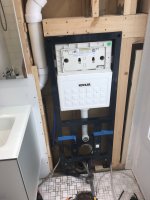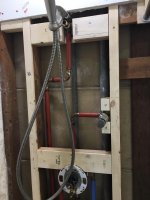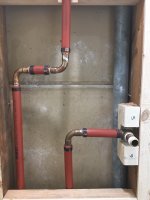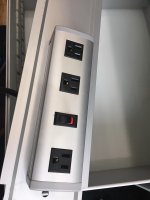ryanjg117
Member
- Joined
- May 18, 2015
- Messages
- 329
Our late 70s home has a lot of issues, but right at the top of the list is our guest/central bathroom. Truly hideous, with brass outlet/switch cover plates, knockdown drywall texture "accented" by strips of flowered wallpaper holding on for dear life, laminate floor, and a laminate covered vanity from the same era. The room itself is a bit awkward in that it's a long-ish room (12') but also a bit too narrow (5') for a soaking tub, something we'd like to add. Also, it features an in-swing door which comes dangerously close to the toilet bowl, a personal pet peeve of mine. Overall, it's just a poor use of space. I made a quick-n-dirty SketchUp video to show you what it looks like today:
Current state
My plan:
* Push out part of the wall and add a soaking tub where the big vanity exists today; make a smaller vanity and place it adjacent to the soaking tub
* Replace combo shower/tub combo with custom walk-in shower
* Move the toilet about 10-12 inches along the back wall, toward the center of the room (necessary for the 38" width of the walk-in shower)
* Replace the in-swing door with either a pocket door or out-swing door
Here's a quick-n-dirty SketchUp video showing my rough idea for the new bathroom:
Future state
I'm fairly confident in my demolition, framing, drywall, electrical and finish work, but plumbing is one area I haven't spent much time. However, I did sweat about 200 feet of copper for the air lines in my workshop a few months back -- so I've got that nailed down. I'm certainly not opposed to doing the plumbing work myself (especially since a local, licensed plumber quoted me $2K just for the rough plumbing work on this project), but I don't really know where to start. A few random questions I have:
* Can I tap into existing vent lines already in place for my sink or shower?
* What diameter drain needs to be used for the soaking tub, and can I merge that into the drain that's currently used for the shower/tub combo? (Will it be possible to drain the shower and soaking tub at the same time?)
* What is the required slope for drains?
* What other plumbing concerns/considerations should I be thinking about?
Current state
My plan:
* Push out part of the wall and add a soaking tub where the big vanity exists today; make a smaller vanity and place it adjacent to the soaking tub
* Replace combo shower/tub combo with custom walk-in shower
* Move the toilet about 10-12 inches along the back wall, toward the center of the room (necessary for the 38" width of the walk-in shower)
* Replace the in-swing door with either a pocket door or out-swing door
Here's a quick-n-dirty SketchUp video showing my rough idea for the new bathroom:
Future state
I'm fairly confident in my demolition, framing, drywall, electrical and finish work, but plumbing is one area I haven't spent much time. However, I did sweat about 200 feet of copper for the air lines in my workshop a few months back -- so I've got that nailed down. I'm certainly not opposed to doing the plumbing work myself (especially since a local, licensed plumber quoted me $2K just for the rough plumbing work on this project), but I don't really know where to start. A few random questions I have:
* Can I tap into existing vent lines already in place for my sink or shower?
* What diameter drain needs to be used for the soaking tub, and can I merge that into the drain that's currently used for the shower/tub combo? (Will it be possible to drain the shower and soaking tub at the same time?)
* What is the required slope for drains?
* What other plumbing concerns/considerations should I be thinking about?




